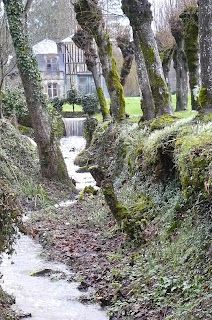Here we are, still in February but everything seems to be waking
up already. Yesterday, even though there was a chilly start to the day, the
birds round us treated us to a good attempt at a dawn chorus. The sparrows that
nest in the holes in our gable wall were squabbling and chattering and the
blackbirds look really busy everywhere.
The
thermometer climbed to a dizzy 9°C yesterday afternoon and with a completely
clear blue sky, you could be forgiven for thinking that spring had arrived. Officially,
we have to wait another four weeks for that.
I noticed
that the flower buds on the three peach trees in the orchard are beginning to
swell. I have already given them a precautionary treatment against peach leaf
curl. It was really bad in last year’s humid conditions and it was only
Bordeaux mixture which finally seemed to do the trick.
The bees
were extraordinarily active yesterday afternoon. All the queens are now in lay
and whenever there is a chance, the field bees get outside in order to gather
pollen, a little nectar where they can find it and of course, water. Most of
the pollen coming in at the moment is from the Hazel catkins and bright yellow but
some of the bees were coming back with pinky orange pollen in their baskets. Perhaps
from Alder catkins or perhaps from Snowdrops?
I watched
some bees working amongst the Celandine flowers which have opened along a sunny
bank under the woods. Here they seemed to be collecting nectar rather than
pollen as they were going from flower to flower without stopping to pack
anything into their baskets.
The first dandelions
have started to open and together with the daisies, Celandine, Snowdrops, Crocus,
Primroses, Viburnum Tinus and Gorse which are all in flower at the moment, the
bees have a pretty good selection to choose from. So far, amongst the trees it
is only the Hazels and Alders which are providing anything useful in terms of the
quantity of pollen the hives need for their spring build-up but the Willows are
just beginning to bud.
We are
expecting a few cold days now with a wind from the north-east so I should think
that things will slow down for a while. Two steps forward, one step back!
 |
| These two field bees are bringing in pollen from
different sources, - the yellow from Hazel catkins and the orange
probably from Alder. The bee nearer to the camera is possibly older
than the other since she has less "fur" on her thorax and abdomen. |
 |
| Like a flight of bomber aircraft coming in to land, three Caucasian bees bring in a good load of Hazel pollen during the afternoon of February 19th. |
 |
| This bee is collecting some nectar from a Celandine flower. There are no big nectar flows in this region until the Dandelions flower from March onwards. |
 |
| The
Dandelion, Taraxacum officinale, will not really be in full bloom until
some time in March but there are already a few flowers around. | | | |
 |
| There probably is no month of the year when the Daisy, Bellis perennis, is
not in bloom. Even after the most severe frosts or when there is snow on
the ground, they just keep on flowering. |
 |
| An old favourite, Virburnum tinus, an evergreen which comes into flower here at the end of winter and keeps going until the early summer. Quite a number of insects like visiting the flowers. |



















